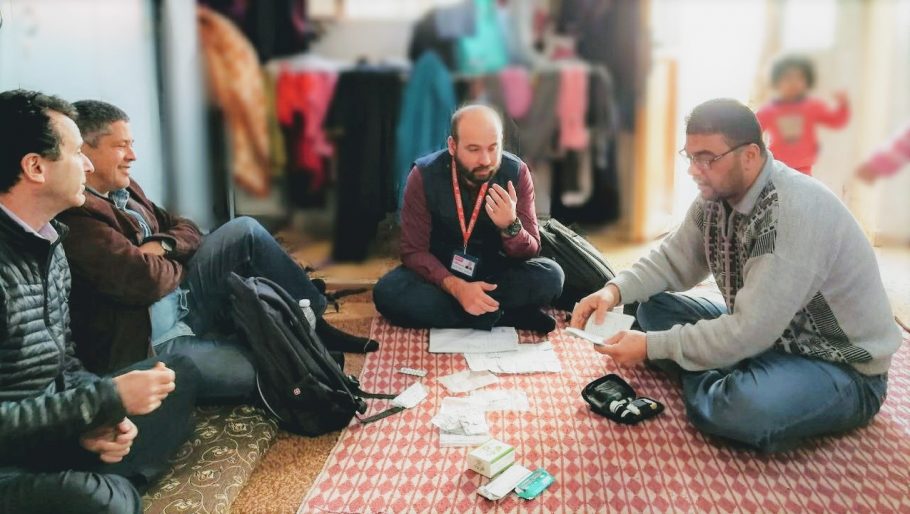Can Cash Transfers Help Syrian Refugees Manage Diabetes?

Providing refugees with cash assistance is increasingly common in humanitarian contexts and multipurpose cash is becoming a modality of choice. Yet critical questions are still being explored such as who should receive cash and how can it be used by the sectors without compromising standards?
As the numbers of refugees and displaced persons continues to grow worldwide, so do demands placed on host country health systems. Displaced populations suffer from an increasingly larger burden of chronic conditions, and health systems in host countries need to be provided with the support to adapt to this new reality. In many settings, a basic package of services is available at low cost, but services outside this package may remain costly and so financially out of reach.
To better understand the impacts of cash transfers combined with various health interventions on refugee health, our consortium conducted a study to assess the impacts of cash assistance on Syrian refugees with diabetes who reside in the greater Amman area of Jordan.
Reducing the financial barriers to medication and health care treatments for refugees with diabetes is critically important because when household finances are stretched thin, families tend to prioritize food and shelter, and may forgo costly medical needs.
Comparing three different approaches to managing diabetes
With support from Research for Health in Humanitarian Crises (R2HC), we set up a study to compare three different approaches to managing diabetes with refugees. Study participants were followed for one year and change in diabetes-related outcomes assessed. The different approaches were:
| Approach | Quarterly education sessions | Home Support visits | Recipient | Transfer | Transfer condition |
| Group 1 | Yes | Yes | Patient | None | N/A |
| Group 2 | No | Yes | Patient | US$211 each quarter | Diabetes care and medication |
| Group 3 | No | No | Household | US$113–219 each month | Multipurpose (no use condition) |
What did we learn?
Over the course of the study, Group 2, who received the combination of health education sessions and conditional cash transfers had significantly greater improvements.
They were the only group with a significant increase in regular visits to a doctor and specialist care for diabetes; they spent more on outpatient diabetes care, monthly medications, and glucose monitoring supplies and they missed necessary testing, medications, or referral care less often.
Overall diabetes control (measured by HbA1C) improved significantly for the community health volunteer group (Group 1, 9.1%) and the community health volunteer and conditional cash transfer group (Group 2, 11.7%). The group receiving the unrestricted multi-purpose cash transfers (Group 3) had the least improved health outcomes out of the three groups.
For best results provide CVA alongside other health-focused support
What does this tell us? Firstly, health education interventions work. So, particularly when targeting chronic diseases, humanitarian organizations considering using cash transfers for health should also consider adding health education interventions. Furthermore, when cash transfers are not feasible, those in the health sector should use community health education interventions alone because these were effective in improving diabetes outcomes. By contrast, when funds were given for household use without health education and home visit support, the impact for the patient was limited. Considering the many competing priorities for spending and the fact that the patient may not have been involved in the decision making, this perhaps not surprising.
While this research was not without its flaws (a fourth arm of MPC plus education or even a fifth arm of MPC plus a strong message around diabetes control for the patient would have taught us a lot), the research suggests that cash transfers plus home base health interventions and education do represent a potential solution in easing the burden on health systems, and supporting better health outcomes for refugees.
If you are interested in finding out more about how CVA can support improved health outcomes in conditions of extreme poverty, then please do attend the CALP Network’s webinar on March 30.
The research study was conducted in collaboration between the Johns Hopkins Center for Humanitarian Health, Medair, and the United Nations High Commissioner for Refugees. This research project is funded by Elrha’s Research for Health in Humanitarian Crises (R2HC) Programme, which aims to improve health outcomes by strengthening the evidence base for public health interventions in humanitarian crises. The R2HC programme is funded equally by the Wellcome Trust and the UK Government.
Main image: A home visit by a Medair community health worker to a diabetic study participant in Amman, Jordan. Credit: Shannon Doocy. February 2019


